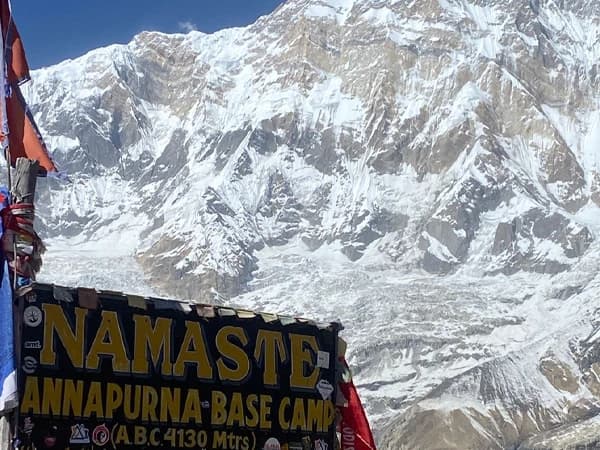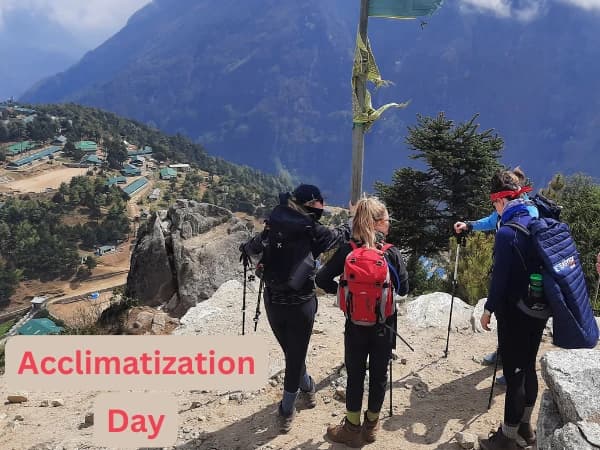While the Annapurna Circuit is the most famous route, there are plenty of other treks in the Annapurna Conservation Area. Nepal has so many hidden gems, and you’re never too far from a less-travelled path that offers its own unique beauty. But before you set off, it’s important to know about a new rule.
Important Update:
As of April 1, 2023, all foreign trekkers must now have a licensed guide when trekking in Nepal’s mountains. This new rule helps ensure that everyone is safe and supported on their journey.
What is the Annapurna Circuit?
The Annapurna Massif is one of those places that leave you in awe. It’s home to some of the highest mountains in the world, with Annapurna I leading the way at 8,091 meters that's making it the 10th tallest mountain on Earth. But the massif is far from just one peak. There are 13 others over 7,000 meters and another 16 that go beyond 6,000 meters. So, yeah, it’s a pretty incredible place to be surrounded by giant mountains.
This massive mountain range stretches 55 kilometers across the landscape. On the western edge, you’ll find the Kali Gandaki Gorge, the deepest gorge on the planet, cutting right through the massif. It separates Annapurna from Dhaulagiri, the 7th highest mountain in the world. The Marshyangdi River flows through the north and east, while the stunning Pokhara Valley sits to the south.
The name "Annapurna" comes from a Hindu goddess who symbolizes food and nourishment. Legend has it that she’s the daughter of Himavat, the king of the mountains, which is why her name was given to these majestic peaks.
Why is Annapurna I So Dangerous?
Annapurna I isn’t just another mountain in Nepal. It’s a symbol of both incredible achievement and harsh reality. In 1950, it became the first peak over 8,000 meters to be conquered by humans, marking a historic moment in mountaineering. However, despite this feat, Annapurna I is notorious for its danger. With a high fatality rate, it’s a mountain that has claimed the lives of many. Most trekkers now choose to admire its beauty from the safety of nearby trails, rather than risk the climb.
For those looking to immerse themselves in the magic of the Annapurna region, the Annapurna Circuit offers one of the most iconic trekking experiences in Nepal. Winding through deep valleys, lush forests, and towering peaks, the circuit draws trekkers from around the world. While the full circuit is the main attraction, other shorter routes like the Jomson trail also offer fantastic adventures in less time.
One of the most stunning routes is the Annapurna Sanctuary trek. This path leads hikers to the Annapurna Base Camp, nestled in a breathtaking glacial basin surrounded by some of the world’s tallest mountains. Though many trekkers add it as a side trip, the Annapurna Base Camp trek itself is a challenging journey that can be done over several days, offering a perfect escape for those seeking adventure and peace.
With every passing year, the Annapurna region sees an influx of trekkers, especially during peak trekking seasons. As one of the busiest trekking spots in Nepal, the circuit continues to attract travelers seeking unforgettable mountain views and cultural experiences. In fact, about two-thirds of all tourists visiting Nepal come for a trek in the Annapurna region. While the Annapurna Circuit reigns supreme, another major gateway for trekking is Lukla Airport, leading to the Everest region and beyond. Nepal’s mountainous wonders are waiting to be explored, and Annapurna remains one of the best starting points for any adventure.
The Annapurna Circuit
The Annapurna Circuit is one of Nepal's most legendary treks, winding its way through some of the country’s most awe-inspiring landscapes. The route can take anywhere from 12 to 22 days to complete, depending on how much time you want to spend soaking in the beauty around you. With distances ranging from 160 to 230 kilometers, the trek offers plenty of opportunities to explore, including detours like a visit to the stunning Tilicho Lake or the famous Poon Hill for breathtaking sunrise views.
One exciting side trip is the Annapurna Sanctuary, where trekkers can take a detour to Annapurna Base Camp, then rejoin the main trail later. While you can speed things up by using dirt roads built by the government but a bit controversial for some that you miss the heart of the trek, the high mountain passes. These higher trails are where the real magic happens, offering some of the most stunning views of the entire journey.
The views on the circuit are simply unforgettable. You’ll get a front-row seat to the Annapurna peaks, including Annapurna I, II, III, and IV (yes, we promise that’s its real name). Plus, you’ll see Dhaulagiri, towering at 8,167 meters, and the iconic "Fishtail" peak, Machhapuchhre, standing proudly in the distance.
What makes this trek even more special is the ever-changing scenery. You’ll pass through traditional villages tucked in lush valleys, cross sub-tropical forests, and walk along terraced rice fields. The contrast of the landscape as you go higher into the mountains makes each day unique.
At the end of each long trekking day, you’ll stay in cozy teahouses. These are the heart and soul of the trek, where you’ll rest, share stories with fellow trekkers, and enjoy delicious local meals. Dal Bhat, a simple but hearty dish of rice and lentils, is a favorite and often served as a “bottomless” meal, making it perfect after a long day on the trail.
How Long to Walk the Annapurna Circuit?
One of the best things about trekking the Annapurna Circuit is that it’s a loop. This means you’ll always have a new perspective, and you won’t be retracing your steps or seeing the same views twice how cool is that?
The trek usually starts in Besisahar, a subtropical town, and ends in the beautiful city of Pokhara. Most trekkers hike the circuit in an anticlockwise direction. This route is popular because it allows for a gradual increase in altitude, which makes it safer when crossing Thorong La Pass, one of the highest points on the trek.
What’s also great about the Annapurna Circuit is that each journey is unique. Some trekkers take detours, others might take more time to adjust to the altitude, and some even take extra days to rest. No two treks are exactly the same, but here’s a look at a typical 19-day itinerary to give you an idea of what you might experience:
-
Kathmandu to Besisahar (drive).
-
Besisahar to Bulbule.
-
Bulbule to Jagat.
-
Jagat to Dharapani.
-
Dharapani to Chame.
-
Chame to Pisang.
-
Pisang to Manang.
-
Acclimatization and exploration in Manang.
-
Manang to Yak Kharka.
-
Yak Kharka to Thorong Phedi Base Camp.
-
Thorong Phedi Base Camp to Muktinath via Thorong La Pass (5416m).
-
Muktinath to Kagbeni.
-
Kagbeni to Marpha.
-
Marpha to Larjung.
-
Larjung to Ghasa.
-
Ghasa to Tatopani.
-
Tatopani to Ghorepani.
-
Ghorepani to Tikhedhunga.
-
Tikhedhunga to Nayapul and drive to Pokhara.
How Difficult is the Annapurna Circuit Trek?
Well, that depends entirely on you. It’s a trek that asks for a certain level of fitness, but it’s also about the route you choose, your mindset, and how you pace yourself. Some days will push you, while others will let you breathe a bit easier.
With the new dirt roads in place, some trekkers are opting for a shortcut. You can now take a jeep to skip parts of the trek, cutting down the time it would have originally taken. For some, it’s a welcome relief, while others argue it’s missing out on the full experience. But if you want to stick to the scenic, traditional route, the dirt roads are optional, and a good guide will help you get the most out of your trek without cutting corners.
A full Annapurna trek is demanding, no doubt. It’s not a casual walk, but that’s what makes it so rewarding. You'll need to be fit, but the great thing is, you can take it slow, enjoy the journey, and settle in for cozy nights by the fire. Expect early mornings, afternoons of walking, and days that range from 5 to 7 hours of trekking.
If you’re worried about the load, hiring a porter can make a huge difference. Having someone carry your gear means you can enjoy the trek without the extra strain. It’s important to choose a guide who treats porters with respect, ensuring they are fairly paid and not overburdened.
How High is Annapurna?
When it comes to tackling the Annapurna Circuit, no amount of city trekking prep will fully prepare you for the altitude. Once you cross the 2,500-meter mark, you’ll start feeling the thinner air, and it’s something you can’t ignore. As you plan your trek, it’s crucial to factor in rest days to give your body time to adjust to the higher altitudes. Everyone reacts to the altitude differently, so what works for one person might not work for another.
At Thorong La Pass, the highest point of the trek at 5,416 meters, the air has only about half the oxygen of what you'd find at sea level. That can make even the simplest tasks feel like a real challenge. This is where having an experienced guide is invaluable. They’ll help pace you properly, monitor your health, and know when it’s time to turn back if necessary, keeping you safe throughout the journey.
Acclimatization isn’t just something they talk about in online guides it’s essential. Rushing through the trek could seriously impact your health, so don’t rush it. Give your body the time it needs to adjust.
But don’t let the fitness requirements scare you off. If you’re mentally prepared and in decent physical shape, you’ll be able to handle the trek, even without prior experience. The terrain isn’t overly technical, and with a well-planned pace, you’ll have plenty of opportunities to enjoy the journey at your own speed.
How Cold does it get on the Annapurna Circuit?
The weather on the Annapurna Circuit can vary dramatically depending on when and where you're trekking. In the winter months, you’ll experience cooler temperatures, with daytime highs averaging around 5-10°C. But as you gain altitude, things can get seriously cold reaching as low as -20°C, especially at higher elevations, and even colder at night.
In the warmer months, temperatures are much more manageable at lower altitudes, ranging between 15-23°C (below 2,500m). However, as you climb higher, especially above 4,000 meters, the temperature will drop again, often falling below 10°C. At Thorong La Pass, the highest point of the trek, it can even be below freezing so yes, even in the summer, you'll still need to pack warm layers.



